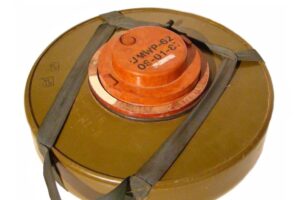RUSSIALINK: “Russia Lays Mines at ‘Industrial Level’ Ahead of Ukrainian Counteroffensive” – Moscow Times

(Moscow Times – Brawley Benson – May 31, 2023)
When Ukrainian forces launch their long-awaited counteroffensive this summer, they will be up against multiple lines of Russian fortifications stretching hundreds of miles from the Black Sea to Ukraine’s northern border.
The military hazards include trenches and anti-tank obstacles, but Russian soldiers have also been busy laying thousands of landmines.
“What we’re seeing is just industrial level … industrial mine-laying,” said Michael Newton, the head of landmine clearing organization HALO Trust’s Ukraine program.
Beyond the military challenge posed to advancing Ukrainian troops, Russian minefields will likely cause hundreds of civilian deaths and require billions of dollars to be safely removed in the coming years, experts told The Moscow Times.
Russia is using a mixture of anti-tank and anti-personnel mines, according to a report from the British Royal United Services Institute released earlier this month.
Mines are an integral part of defensive fortifications like those in Russian-occupied areas of southern and eastern Ukraine, which are usually designed to funnel advancing infantry into positions that leave them vulnerable to counter attacks and artillery barrages.
“We use them to mine certain crossroads, to cover our troops on the flanks, so that the enemy doesn’t break through,” one Russian soldier said in a video posted to Telegram by the Russian Defense Ministry last week.
Mines being used range from the TM-62, which detonates under the weight of a passing vehicle, to the advanced PTKM-1R, which uses sensors to detect and drop a submunition on vehicles.
Human Rights Watch has documented the use of more than a dozen different kinds of mines in Ukraine since the start of Russia’s full-scale invasion last year. These include banned rocket-fired anti-personnel mines — also known as “butterfly mines” — that the organization claimed have been deployed by Ukraine.
Unlike Russia, Ukraine is one of 164 states to have ratified the 1997 Ottawa Treaty that seeks to eliminate the use of anti-personnel landmines.
Ukrainian Prime Minister Denys Shmyhal said in January that Russia had created the “largest minefield in the world” in Ukraine, claiming that over 40% of the country was contaminated with mines.
Landmines are notoriously difficult to find — either by soldiers on the ground or by analysts looking at satellite imagery.
Nevertheless, experts told The Moscow Times that Russia was almost certainly deploying mines alongside concrete “dragon’s teeth,” “hedgehogs” made of iron, barbed wire, trenches and ditches in its massive network of defensive fortifications.
“You would lose a lot of the purpose and usefulness of these fortifications if you didn’t combine them with minefields,” said Pasi Paroinen, an open-source analyst affiliated with the Finnish Black Bird Group.
“They are really a key part of the entire equation.”
Mines have likely been laid all around Russia’s defensive positions, which are particularly dense in southern Ukraine where many believe Kyiv’s forces will seek to achieve a breakthrough.
Based on his analysis, Paroinen said it appeared Russia had started building fortifications further away from the frontlines and gradually inched construction closer as time went on.
It was continuing to reinforce them as spring turned to summer.
A Ukrainian explosive ordnance disposal expert working in eastern Ukraine, who requested anonymity to speak freely, told The Moscow Times that he sees mines “almost everywhere, in vegetable gardens, houses, fields.”
“Many traps were set in administrative buildings and houses of de-occupied territories,” he wrote in a message.
At least 271 people have been killed and more than 500 wounded by mines and other “explosive remnants of war” since the Kremlin ordered tanks into Ukraine last year, the United Nations said earlier this month.
There are few ways of dealing with landmines while combat is ongoing, according to Matthew VanDyke, the founder of Sons of Liberty International, a Washington-based organization that has sent U.S. veterans to train Ukrainians on landmine removal.
“They don’t really have time to detect [them] if they’re under fire,” he said. “So the general rule is just to avoid it.”
Instead, the task of eliminating the threat usually falls on professional deminers after the fighting has ended.
But demining is fraught with danger and can be eye-wateringly expensive.
The World Bank recently estimated that removing all explosive ordnance in Ukraine could cost $37.6 billion over the next 10 years.
And the economic dimension of the issue is made more pronounced because Ukraine relies heavily on its agricultural industry — and mines make farming extremely risky.
Soviet and Russian troops have long used landmines, with Soviet forces deploying them extensively in Afghanistan in the 1980s and Russian soldiers laying mines in Chechnya during separatist wars in the mid-1990s and early 2000s.
In both cases, the consequences are difficult to measure — but they appear to be brutal and long-lasting.
Since the late 1980s, for instance, an average of 110 people have been killed or injured by landmines and unexploded ordnance in Afghanistan each month, according to the United Nations.
Mines were also used extensively by Russian-backed separatists when they launched an insurgency in Ukraine 2014. The years that followed saw “sporadic” mine-laying in eastern Ukraine, according to Human Rights Watch — a precursor to the mass mining underway at the moment.
Newton, the HALO Trust regional director, said that there will likely be a spike in casualties as displaced Ukrainians return home.
Before the invasion last year, he said, his organization estimated it would take 20 years to fully clear eastern Ukraine of mines. But now it will likely take significantly longer.
“Regardless of the threat of landmines, people in many parts of Ukraine don’t have a choice but to get out and still do their business,” Newton said.
“This is ultimately the new normal being created for the Ukrainian people.”
[article also appeared at themoscowtimes.com/2023/05/31/russias-tank-losses-in-ukraine-surpass-2000-osint-report-a81346]
